This website is supported by its readers. If you click one of my links I may earn a commission. I am also a participant in the Amazon affiliates program and I will also earn a commission from qualified purchases.
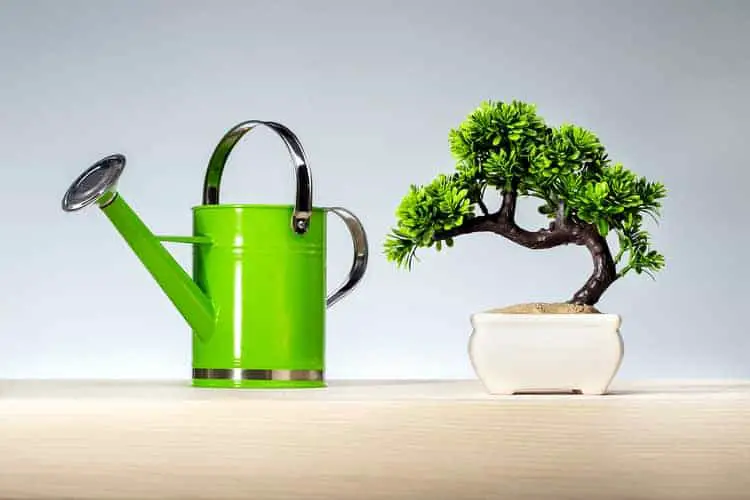
Overwatered bonsai. Sounds too good to be true, right? One of the things I realized when I first started my journey in bonsai was how easy it was to overwater bonsai. So what are the symptoms of an overwatered bonsai?
Overwatered bonsai symptoms include yellowing leaves, shriveling of secondary and tertiary branches, mold, root rot, and fungal infections are also commonplace. Overwatering bonsai deprives the roots of oxygen, stunting the tree’s growth. Overwatering is commonplace in poor soil drainage.
Ensure that you only water your bonsai when the topsoil is dry. Watering once per day is enough for most bonsai.
So how exactly can you counteract, reverse and revive an overwatered bonsai tree? And what are some quick tips you can follow to ensure you never overwater a bonsai tree in the future? Keep reading to find out more.
Just a quick heads up, over the past three years of running Plantpaladin, hundreds of people have asked for product recommendations. As such, You can find my favorite indoor bonsai tree here (link takes you to Bonsaiboy), my favorite outdoor bonsai tree (link takes you to Bonsaiboy), or have a look at all the products I recommend here.
What are the symptoms of an overwatered bonsai?
We must identify the significant symptoms of an overwatered bonsai, so we don’t repeat this and potentially damage our tree.
The significant symptoms then are:
- The topsoil of your bonsai is constantly damp or moist
- The leaves of your bonsai are starting to turn yellow
- The secondary or tertiary branches of your bonsai have started to wilt
- The leaves on your bonsai have started to fall off
- White spots on the leaves of your bonsai
- Poor health, so more fungal or mold infections on your tree
- Moss growing on your bonsai without you planting it
- Root rot
Let’s explore these below:
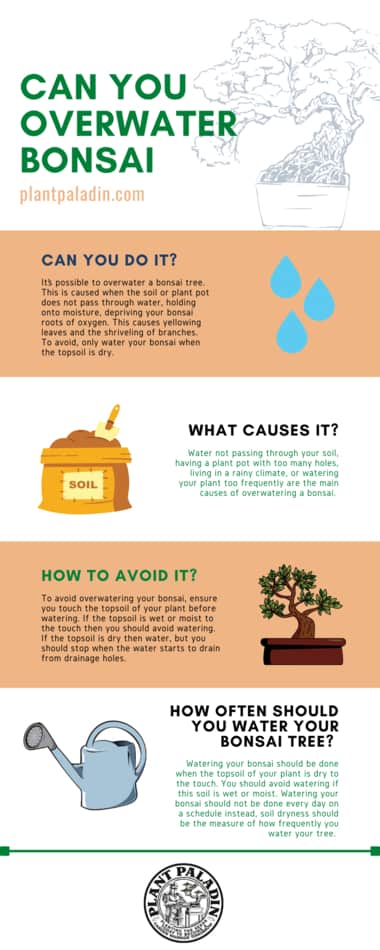
Wet topsoil
The most common sign of an overwatered bonsai is wet soil.
If you touch your topsoil and find that it is moist to the touch still or can see tiny water bubbles, then your bonsai does not need watering.
Bonsai should only be watered when the topsoil is dry to the touch.
If this problem persists, it is usually because your bonsai pot does not have enough drainage holes.
Wet topsoil can be commonplace in overwatered bonsai is that people often miss watering their bonsai on certain days and so overcompensate by overwatering their trees.
As such, setting up a schedule is super important to avoid wet topsoil in the future.
Yellow leaves
Another surefire sign that your bonsai has been overwatered is the sudden appearance of yellow leaves. As bonsai get overwatered, their performance decreases as the roots become suffocated. This causes a chain reaction that, if not resolved, will cause your bonsai leaves to turn yellow.
Believe it or not, plant roots need air and oxygen in the solid to function correctly despite being under the soil.
Bonsai roots without air or oxygen will impede your plant’s ability to absorb nutrients.
Lack of nutrients can cause regression in your bonsai and, if left unchecked, potentially even kill your plant.
Drowning the roots of your bonsai with water will impede this process, and your bonsai will have to hold onto its vital functions, causing your leaves to turn yellow as a way to cope with the added stress.
Yellow leaves are easier to spot on bonsai species, such as elms that have a lot of leaves, than evergreen species, such as junipers.
It’s essential that if you have a coniferous tree, you pay extra close attention to the other signs laid out in this post.
Shriveled branches
Shriveled branches and, in particular, shriveled branches on the secondary and tertiary branches of your bonsai tree are a sign that you have overwatered your bonsai.
As your bonsai becomes stressed, it cannot pass nutrients to all parts of your bonsai, causing these branches to shrivel.
Similar to the point above, as soon as you overwater your bonsai, it will start to find ways to become more efficient.
With secondary and tertiary branches often being pruned anyway in bonsai, your bonsai will naturally see these outer extremities as not vital to the health of your bonsai and will often cause these to fade.
What’s even worse is these branches, if they become too dry and shriveled up, may die – with no chance of reviving them.
Think of it as getting frostbite on your extremities if you were to walk around the arctic without any protective gear.
This can be a gut punch to bonsai owners who often vie for significant bonsai ramifications in our trees.
Falling leaves
Similar to branches turning yellow, the following defense mechanism your bonsai will use if it is overwatered is to cause your leaves to fall off.
While yellow leaves are bad enough, you can usually revive them.
Falling leaves, on the other hand, are much more severe as these leaves are, in most cases, not growing back.
You see, your bonsai will see these leaves as directly hindering your bonsai’s ability to perform.
Often these falling leaves will signal that the branches they are attached to are also dead, so you mustn’t let your leaves get this bad.
White spots on bonsai leaves
White spots, powder, or a white film on your bonsai is a surefire sign that you have a fungal infection.
While fungal infections are common in bonsai, a weekend bonsai immune system brought about by overwatering your bonsai can make it more common for these diseases to impact.
After all, if your bonsai is healthy, it is much less likely to suffer from these diseases.
If left unchecked, this disease can spread throughout your bonsai collection, so you must address it as soon as you spot it.
To avoid this, use a fungicide and stay away from overwatering using the tips laid out in this post.
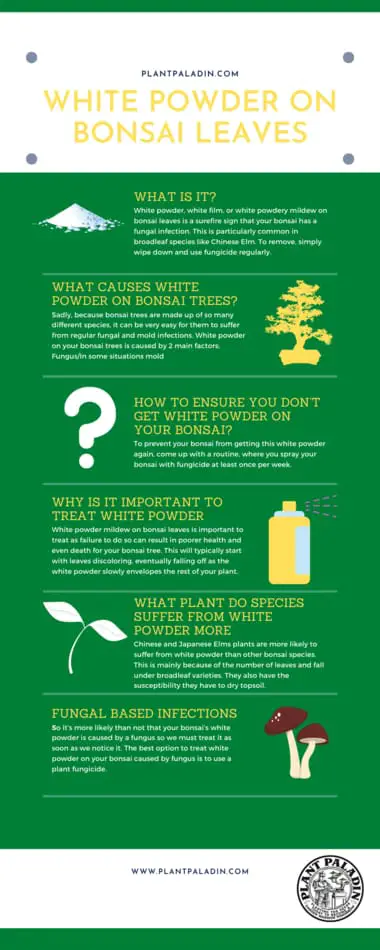
Mold infections
Like fungal infections, mold infections will also be commonplace if you overwater your bonsai – due to weakened plant health.
What’s worse about mold infection is that they thrive in wet, damp conditions; this will be much more apparent in an overwatered bonsai.
If left unchecked, mold can rot your bonsai trunk and create the perfect conditions for an insect infestation.
Mold infections usually start at the bottom of the bonsai, on the topsoil or trunk, so you will need to remove as much of the infected soil as possible and thoroughly wipe down the trunk of your tree with a soapy solution.
Moss growth on bonsai
Mosses such as sphagnum moss are commonly used in bonsai to help get water into your bonsai and for decorative purposes.
If you did not plant the moss directly and your bonsai topsoil is showing signs of moss, then this is a surefire sign that you have overwatered your bonsai.
Mosses thrive in wet conditions.
What’s even worse is that because mosses hold onto water – sometimes up to 8 times their weight – it is likely to exacerbate further the problems caused by overwatering your bonsai.
It’s essential to remove this moss as soon as you see it – I find using a bonsai carving tool to peel back the moss works best.
Root rot
Finally and arguably most dangerously, we come to root rot.
Root rot is caused when your bonsai has been overwatered.
Roots need moisture, oxygen, and aeration to complete the nutrient flow into your plant.
If you overwater your plant constantly, it will cause your roots to die.
Root rot can also quickly be passed on from root to root if left unchecked.
You can quickly end up killing the roots and, in turn, the entire plant.
How to treat root rot in bonsai?
To recover root rot, remove your plant from its pot, wash the soil from the roots of your plant, and then trim the infected roots from your bonsai using a pair of shears or scissors.
Infected roots will usually be darker but don’t be surprised if you have to trim many of the roots away.
I’d also recommend you prune around half of the leaves on your bonsai to give your roots the best chance of survival.
Then dispose of the old soil you used and repot your plant, using a fungicide to remove any water-borne diseases that your bonsai might have picked up.
Should the roots of your bonsai start to root, they will not be able to pass.
What overwatered bonsai symptom is the worst?
Root rot is easily the worst symptom brought about by overwatering bonsai. It can be tough to manage and reverse and will spread to the other roots of your bonsai. If left unchecked, your bonsai will be dead within a few weeks.
How to revive an overwatered bonsai?
If you are reading this post, it’s most likely because you have sadly overwatered your bonsai.
Luckily, you can follow some immediate steps to reverse the process and help your bonsai dry out.
These include:
- Leave your bonsai outdoors to dry
- Using a hot air dryer
- Repotting your bonsai
- Planting your bonsai in the ground
Let’s explore these in more detail
Leave your bonsai outdoors to dry
If you live in a hot climate, one of the best things you can do to counteract the effects of an overwatered bonsai is to leave your plant outside to dry.
Allow your bonsai to drain naturally; the heat will help evaporate excess water.
If your bonsai has a lot of water in it and has been wet for a few days, I would consider removing the pot, opening up the soil, and letting the roots of your bonsai breathe.
Use a hot air dryer
Now, if you live in a much more wet climate, it won’t be feasible to dry your overwatered bonsai outdoors.
In this scenario, you will likely be keeping your bonsai indoors.
To dry, then, move your bonsai into a bathroom or bathtub.
Then remove the pot, open up the branches as you would normally, and then dry thoroughly with a hairdryer – preferably in a warm or hot setting.
Keep away and do not blast with hot air close up, so you don’t burn your bonsai.
I found around 10cm works best.
Repot your bonsai
If you find that it has been a few days and the soil of your bonsai is too wet, or you are worried about getting root rot, you must remove and repot your bonsai.
Carefully move out of your pot, and in my opinion, use a bigger pot to help your bonsai dry.
A bigger pot will give the added air any oxygen that the roots of your bonsai have been craving.
I’d also repot in a soil mix with a lot of pebbles or moisture-absorbing pebbles to further help with the water flow of your bonsai.
Repotting the bonsai with more drainage holes will further aid the water flow.
Plant your overwatered bonsai in the ground
While repotting your bonsai and the above methods will work well for most of you, if you have a larger bonsai or an imperial-sized bonsai (up to two meters), getting rid of the excess water will be a bit more of a challenge.
Luckily one of the best things you can do in this situation is to plant your bonsai in the ground.
Planting in the ground will give your bonsai roots more soil to help them dry out and works incredibly well if you live in a warmer climate or the summer months.
For a full breakdown, check out my blog post here.
What causes overwatered bonsai?
A wet rainy climate, poor drainage holes, soil that does not allow water to flow correctly, and owners overwatering their bonsai are the four leading causes of bonsai overwatering.
Let’s explore these in more detail:
Having a plant pot with not enough holes
A significant issue that can contribute to overwatering a bonsai is having a pot with no or too few holes.
To avoid this, ensure that your bonsai has enough holes for the sizer of your tree.
You can find a good idea for the number of holes for your bonsai can be found in the below table:
Classification | Size inches | Number of penny-sized holes | Number of pencil-sized holes |
Keshitsubo | 1 to 3 inches | 1-2 | 0 |
Shito | 2 to 4 inches | 1-2 | 0 |
Mame | 2 to 6 inches | 2 | 2 |
Chohin | 5 to 8 inches | 2 | 2 |
Kumono | 6 to 10 inches | 2 | 2 |
Katade-mochi | 10 to 18 inches | 2 | 3 |
Chiu or Chumono | 16 to 36 inches | 2 | 4 |
Living in a rainy climate
If you live in a climate with excessive rain ( like I do in the UK), it may be the excessive rain causing you to overwater your bonsai.
Instead, keep your bonsai in a shelter, nursery, or indoors if possible.
Building your bonsai greenhouse could also be an excellent option to protect your plant from the elements in the summer, or winterizing or building a cold frame for your tree are all fantastic options.
Water not passing through your soil
One of the biggest causes of overwatering a bonsai tree is just that your bonsai soil holds on to too much moisture.
You must find a soil mix that holds onto water to hydrate your plant and allows any excess water to pass through easily.
Soils such as peat soil or soil with sand, pebbles, and other inorganic items such as akadama, perlite, or pumice can help filter the water out.
I like to use cactus soil – to read up more on how I do this, check out this post here.
Watering your plant too frequently
Finally comes the most likely cause of overwatering your bonsai tree – you just water it yourself too much.
It would help if you only watered your bonsai when the topsoil was dry.
To help avoid this, set a regular schedule where you only check your bonsai soil twice per day and no more than that.
Most bonsai are incredibly versatile and won’t have any issues.
How to avoid an overwatered bonsai?
So now we know what the symptoms are of an overwatered bonsai, what causes an overwatered bonsai, and how to revive an overwatered bonsai, let’s explore some preventative measures to ensure you don’t overwater your bonsai in the future in the future.
Touch the topsoil before watering
The most common mistake with overwatering is, well, overwatering your bonsai.
To avoid this, ensure that you only water the bonsai when the topsoil is dry.
Moist topsoil is when you can feel any wetness on the topsoil of your bonsai.
As a good rule of thumb, most bonsai must be watered at least once every three days.
Check your bonsai in the morning and afternoon for its watering needs.
Understand the size of your bonsai
More miniature bonsai, such as fingertip-sized bonsai, must be watered more.
This is because they dry out a lot faster than larger-sized bonsai.
Larger bonsai, on the other hand, such as emperor-sized bonsai, need to be watered less frequently as it takes longer to dry out.
As such, understanding the relationship between size and water is essential.
Luckily I’ve written a post about bonsai size classification, which you can check out here.
As a good rule of thumb, the following table should also help:
Bonsai watering by size
Classification | Size inches | Size Centimeters | Hand size | General size | How many times per day you should check to water |
Keshitsubo | 1 to 3 inches | 3 to 8 centimeters | Fingertip | Tiny | 3 |
Shito | 2 to 4 inches | 5 to 10 centimeters | One-hand | Tiny | 3 |
Mame | 2 to 6 inches | 5 to 15 centimeters | One-hand | Small | 2 |
Chohin | 5 to 8 inches | 13 to 20 centimeters | One-hand | Small | 2 |
Kumono | 6 to 10 inches | 15 to 25 centimeters | One-hand | Small | 2 |
Katade-mochi | 10 to 18 inches | 25 to 46 centimeters | Two-hand | Medium | 2 |
Chiu or Chumono | 16 to 36 inches | 41 to 91 centimeters | Two-hand | Medium | 2 |
Dai or Omono | 30 to 48 inches | 76 to 122 centimeters | Four-hand | Large | 1 |
Hachi-uye | 40 to 60 inches | 102 to 152 centimeters | Six-hand | Large | 1 |
Imperial | 60 to 80 inches | 152 to 203 centimeters | Eight-hand | Large | 1 |
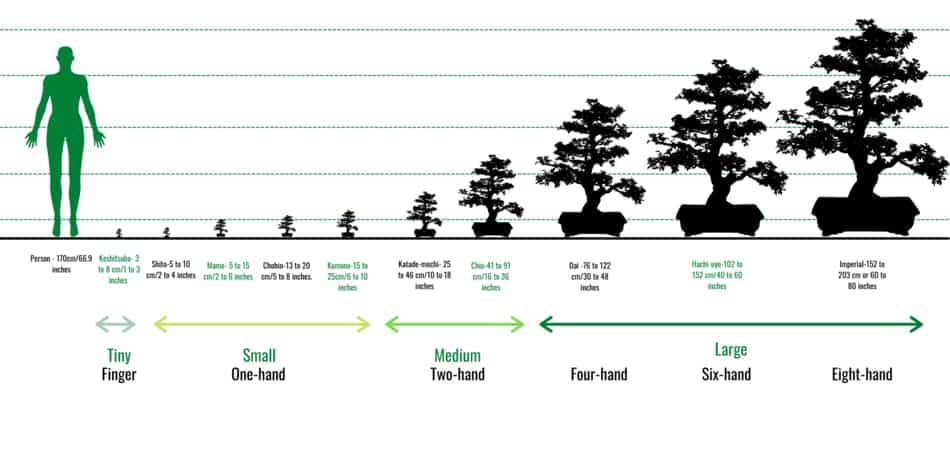
Understand your bonsai species
Bonsai trees are not one species of plant.
Instead, bonsai comprises thousands, if not millions, of subspecies, all pruned and designed to stay small in size.
As such succulent trees, such as jade, will need less water than traditional bonsai species, such as junipers or elms.
Stick to top watering
It can be very tempting to submerge your bonsai in water as a way to water your bonsai.
After all, why waste a lot of excess water on the leaves and get the water directly to the roots where they are needed?
The truth is that if you are a beginner, you will be unfamiliar with the exact water needs of your tree.
Keeping your bonsai submerged in water, so the drainage holes slowly seep the water into your plant can be overdone, leading to overwatering your tree.
I would recommend watering your bonsai with a watering can or spray of some kind.
Pour this on the top of your bonsai for about 30 seconds and let the water drain until dry.
Have a set schedule
Finally, ensure that you have a set schedule.
Often, people overwater their bonsai as a way of overcompensating for forgetting to water their plants for a few days.
The truth is that most bonsai, especially junipers and elms, which are super common, are incredibly versatile, and a few days without water should be fine.
Instead, devise a regular schedule, ideally daily, where you will check your bonsai for their water and overall health needs.
I like to do my checks after work and set up time in my calendar days as a reminder.
Can you overwater a bonsai?
It’s possible to overwater a bonsai tree. This is caused when the soil or plant pot does not pass through water, holding onto moisture and depriving your bonsai roots of oxygen. This causes yellowing leaves and the fading of branches. To avoid this, only water your bonsai when the topsoil is dry.
To read the full article on if it’s possible to overwater a bonsai – which the above excerpt has been taken from, check out my post here.
How to futureproof your bonsai from overwatering?
So now you know how to prevent overwatering, what exactly can you do to futureproof your bonsai from overwatering in the future?
The best method I found was to check my bonsai trees to see if they need watering on a schedule.
I typically do this once daily, first thing in the morning as soon as I get up.
If the topsoil is dry to the touch, then I water it.
If the topsoil is moist or damp, I prevent watering.
Another major step to preventing overwatering in the future is to change my potting soil once per year.
Even potting soils containing inorganic soil material, such as akadama, break down after time and become less efficient at allowing moisture to flow through evenly.
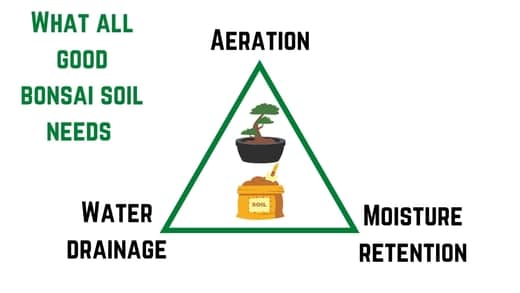
Best watering techniques to prevent overwatering
The best way to water your bonsai tree to prevent overwatering is to top water with a watering can with a nozzle/sprinkle set. This will allow an even distribution of water and prevents water from grouping together in one spot on your potting soil.
Water your bonsai tree for about thirty seconds to one minute – wait until the water starts to pass through the drainage holes of your bonsai pot before stopping.
I would avoid using a humidity tray for prolonged periods as this can lead to root rot if relying on moisture trays too frequently.
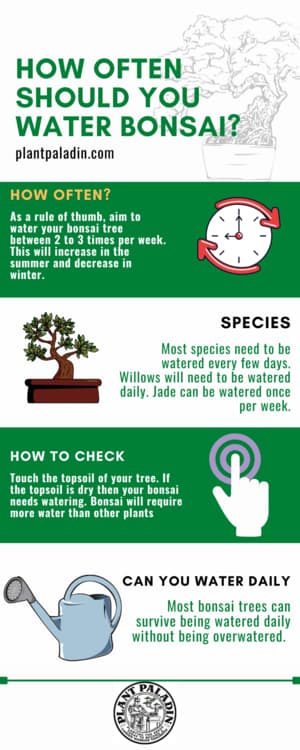
What species are more prone to overwatering?
So while all species of a bonsai tree can be overwatered, some species are much more guilty of being overwatered than others.
The reason?
Bonsai trees are not one species and instead are made up of hundreds of subspecies of different plants.
As such, if the tree’s natural species do not like to be watered too frequently, then there is a good chance the bonsai tree miniaturized version of the tree will not need to be watered too frequently either.
Succulent bonsai species, such as Jade bonsai, are much more prone to overwatering than other species. This is because, in the wild, these succulents do not require that much watering.
Other species, such as willow, which grow naturally in the wild near rivers, ponds, and lakes, love watering, so you will find it more challenging to overwater these trees.
Now to help explain how frequently you should water a bonsai tree species, I’ve put together a table below on several of the most common bonsai tree species:
How often should you water bonsai by species
Bonsai Species | How often should topsoil be checked | How often should the bonsai tree be watered |
Weeping Willow | A few times per day | Daily |
Birch | A few times per day | Daily |
Alder | A few times per day | Daily |
Apple | Once per day | A few times per week when not producing fruit. Daily when producing fruit. |
Lemon | Once per day | A few times per week when not producing fruit. Daily when producing fruit. |
Lime | Once per day | A few times per week when not producing fruit. Daily when producing fruit. |
Orange | Once per day | A few times per week when not producing fruit. Daily when producing fruit. |
Crabapple | Once per day | A few times per week when not producing fruit. Daily when producing fruit. |
Cherry | Once per day | A few times per week when not producing fruit. Daily when producing fruit. |
Ficus | Once per day | Daily to a few times per week. |
Chinese Elm | Once per day | Daily to a few times per week. |
Fukien Tea | Once per day | Daily to a few times per week. |
Serissa | Once per day | Daily to a few times per week. |
Olive | Once per day | Daily to a few times per week. |
Juniper | Once per day | Daily to a few times per week. |
Pine | Once per day | Daily to a few times per week. |
Scots Pine | Once per day | Daily to a few times per week. |
Oak | Once per day | Daily to a few times per week. |
Jade | Once per day | Daily to a few times per week. |
What is the best soil to prevent overwatering bonsai?
The best potting solid to prevent overwatering of a bonsai tree is an inorganic soil mix containing 50% Akadama, 25% volcanic lava rock, and 25% pumice The ideal soil mix should allow for even moisture retention, moisture flow, and aeration.
To read up more on the best potting soil mix to prevent overwatering, check out my post here.
What do the experts say?
As always, I didn’t just want to give my opinion, so I contacted a few experts and asked their opinion on overwatering.
First, I visited my local botanical gardens and spoke to one of the employees there. These were their thoughts:
“It’s a lot less common to overwater bonsai than underwater, but still possible, if you check the soil if it’s dry or not that’s the best measure of when you should water these plants”
I also got in touch with Bournville Garden Centre on a recent visit, and this was their opinion:
“ Overwatering bonsai is not very common but still can be done. The best way to solve this would just be to let your plant dry out and then repot. Should work for most cases”
I also asked my readers which of the above are the worst side effects of an overwatered bonsai, and these were their results:

Overwatered bonsai symptom | Percentage* of Plantpaladin readers who thought this was the most severe problem |
Root rot | 45% |
Leaves falling off | 20% |
Shriveled branches | 15% |
Fungal/mold infections | 10% |
Yellowing leaves | 10% |
Moss | 0% |
Wet topsoil | 0% |
*40 plant paladin readers surveyed.
FAQ’s on overwatered bonsai trees
Now in the time, this post has been up, I’ve received several emails from people asking similar questions on how to revive their bonsai tree.
As such, I’ve grouped some of the frequent ones I receive below:
I have not watered my bonsai tree in 3 weeks, but it is still wet. What do I do?
If your bonsai tree is still overwatered after you have not watered it for a few weeks, then be patient. There is a good chance your bonsai tree needs more time to dry out.
Avoid training, defoliating, or wiring your tree at this time, and give it one to two more weeks to dry out.
Look for signs of new leaf growth; if your tree is still growing new leaves, then your tree is naturally trying to recover from being overwatered.
My bonsai tree leaves have started falling off randomly. Is this overwatering?
The leaf fall might be natural if you feel you have not overwatered your bonsai tree.
The most common bonsai tree species are semi-deciduous, meaning that the leaves fall off for a few weeks during the year.
If it is near the fall, then this is likely the reason why your tree is dropping leaves.
My bonsai leaves have black tips on them – is this overwatering?
Black tips on the leaves of bonsai trees are typically a sign of overwatering. Be patient, avoid watering the bonsai tree for a few weeks, so long as the top soil remains moist, and avoid training your tree.
If, after a few weeks, the tree does not improve, consider using the methods outlined earlier in this post.
My top picks for the gear you will need!
So like I mentioned earlier, over the past three years of running PlantPaladin, hundreds of people have asked me for my recommendations on the best bonsai gear on the market.
Having spent thousands of dollars on bonsai items these past few years and tested at least 100 bonsai-specific products, I’ve listed my favorite products below – All of which I highly recommend and think you can get great value.
They can purchase directly by clicking the link to take them to Amazon.
Bonsai Tool Set: One of the significant challenges I’ve had is finding a toolset that was not only durable but didn’t break the bank. SOLIGT has recently developed a fantastic bonsai tool set that covers all the tools you need to trim, prune, and repot your trees. – You can grab it here.
Complete Bonsai Set: Many of you will want to grow your bonsai trees entirely from scratch, but finding the varicose seeds, pots, and other items in one place can be challenging. Leaves and Sole then have created a complete bonsai set that I’ve personally used that ticks all the boxes. You can grab it here.
Bonsai wire: The number of times I’ve run out of wire for my bonsai or purchased cheap bonsai wire that doesn’t do the job is embarrassing for me to admit. After a lot of trial and error, I found that using Hotop’s aluminum bonsai wire is one of the best options on the market. This can easily be used for both indoor and outdoor bonsai. You can grab it here.
This post was written by Fehed Nicass who has been passionate about bonsai for over 2 years.
